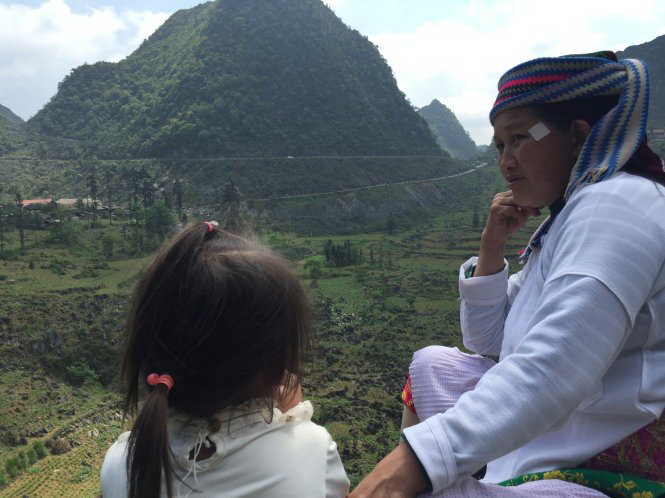An ethnic group of Chinese origin who in ancient times were once cornered by troops from the East Asian empire, Mong people have settled and thrived on mountain peaks in northern Vietnam for the last three centuries and lived in the spirit of freedom.
>> Alpine ethnic people in Vietnam – P7: A different type of funeral
>> Alpine ethnic people in Vietnam – P6: Getting drunk at the market
>> Alpine ethnic people in Vietnam – P5: ‘Wife-pulling’ custom
>> Alpine ethnic people in Vietnam – P4: Unique metalwork
>> Alpine ethnic people in Vietnam – P3: The fight for clean water
>> Alpine ethnic people in Vietnam – P2: Growing crops on rocks
>> Alpine ethnic people in Vietnam – P1: Leading lives aloft
On a treacherously rocky slope in Seo Lung 2 Hamlet, tucked away in Thai An Commune, Quan Ba District in Ha Giang Province, Tuoi Tre (Youth) newspaper reporters heard a khen (Vietnamese panpipe) tune resonating from a wooden chalet on a steep mountain flank.
The haunting melody, played by Ma Khai So, a respected 87-year-old intellectual and famed khen artist, motivated the reporters to ascend the slope to his house.
So is one of very few artisans who can both perform Mong’s legacy of 360 khen pieces and fully understand their significance.
The elder revealed that the tunes embody most of the Mong group’s cultural values and race-related memories.
The heritage, divided into four categories, predominantly reflect the community’s spiritual life, with only a small portion intended for recreational purposes.
So validated his revelation with a long khen piece played at an unhurried pace.
“Did you notice that the tune is as inarticulate as Mong people’s accent?
The tune, said to be the voice of freedom, is part of our group’s soul, history and culture,” he noted.
Hunted down by Han, a major ethnic group of China, the Mong people fled to other countries, including Vietnam, a few centuries ago and have put down roots in the Southeast Asian country ever since, So explained.

Mong girls are seen trudging on the rugged terrain on their way to a festival. Photo: Tuoi Tre
“We Mong people have called the mountain peaks home everywhere we have roamed. We consider ourselves ‘orphans’ and ‘exiles’ and cherish the spirit of freedom, while natives tend to think of us as ‘tramps,’” the elderly man elaborated.
According to researchers, songs about the group’s ‘orphan’ plight are among its five major categories and make up the largest amount of their folk music legacy.
“This is most evident in the ancestral worshipping and funeral rites. All Mong lineages have a ‘driving away the Han enemy’ oration,” Sung Dai Hung, director of the Ha Giang Department of Labor, War Invalids and Social Affairs, shared about his own ethnic group.
Hung is himself a Mong native from Dong Van District.
When a Mong man dies, he is dressed in a traditional linen outfit to prepare him for his afterlife.
The practice dates back to a historical myth in which Han troops allegedly slew only Mong men during their hunt while sparing Mong women out of their fondness for their remarkable beauty.
The women were taken captive as ‘possessions’ by the Han pursuers.
The men thus had to disguise themselves if they were to survive the merciless hunt.
Hung added that the Mong people had chosen to live atop mountains far from the maddening crowd to remain elusive from their Han foes.
His forefathers recounted that up to nine out of ten Mong people were massacred by their enemy during their flight to Vietnam.
Meanwhile, Vietnamese researcher Nguyen Manh Tien, author of a book titled “Nhung Dinh Nui Du Ca” (Singing Heights), observed that the Mong people’s choice of habitat was the price they paid for their independence.

Ma Khai So, a respected 87-year-old Mong intellectual and famed khen (Vietnamese panpipe) artist, performs with his instrument. Photo: Tuoi Tre
“Despite being latecomers to Vietnam’s northeastern and northwestern regions, the Mong people, known for their steadfastness and intrepidity, fought against the earlier occupants of the lowlands, namely Tho Ty, Quang Tay, Phia and Tao Thai,” Tien wrote in his book.
Their defeat in the wars and refusal to yield in to the victors’ dominance prompted them to cluster at a height of 800 meters.
The lofty locations, which serve as sturdy fortresses from Han troops and other intruders, however, also lack a natural water supply, vital for farming and daily consumption, and thus are not infested with leeches.
Dr. Mai Thanh Son, of the Central Region Social Sciences Institute, under the Vietnam Academy of Social Sciences, confirmed that the Mong people’s choice of habitat is also of historical necessity.
Pundits on Mong history have said that the ethnic group had no choice but to drive away the Lo Lo people, earlier inhabitants on the mountain peaks, shortly after they set foot in northern Vietnam.
It explains why orations given at worshipping rituals held by the descendants of Mong lineages all mention the Lo Lo people with profound respect and gratitude.
Like us on Facebook or follow us on Twitter to get the latest news about Vietnam!





















































